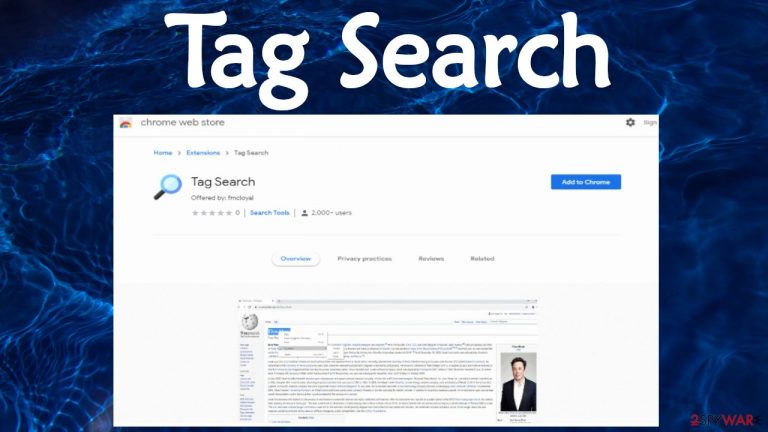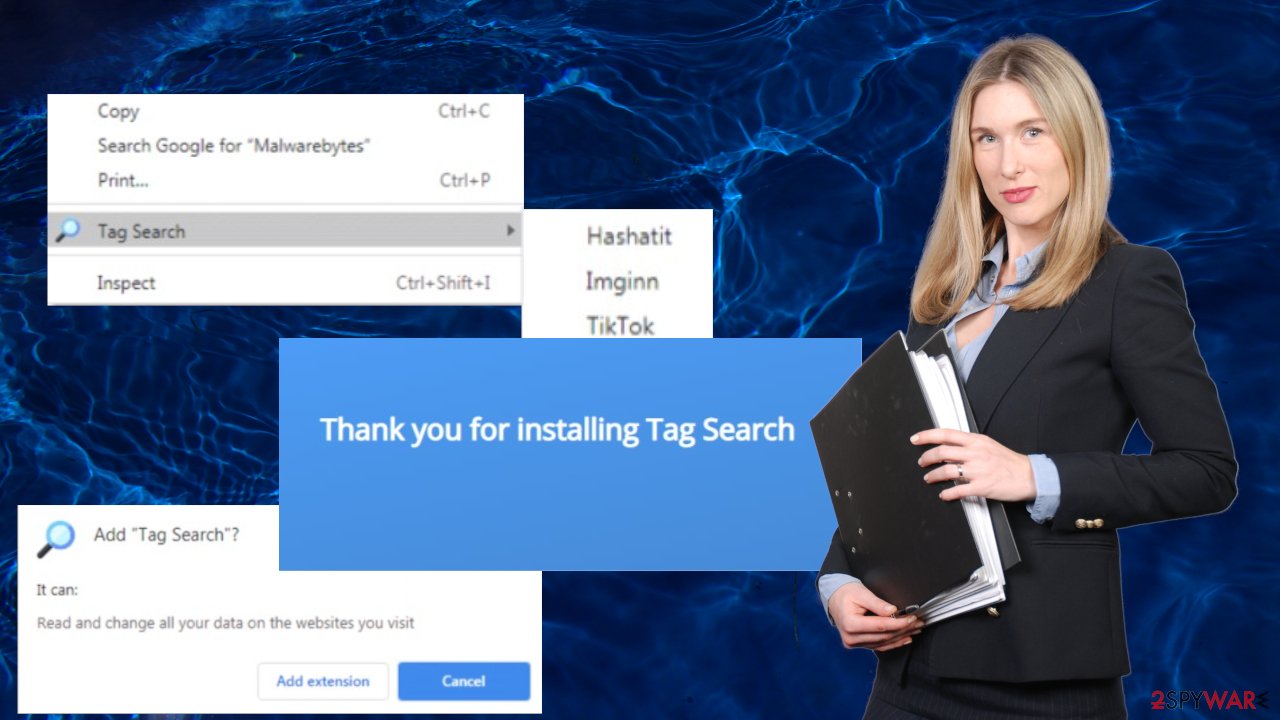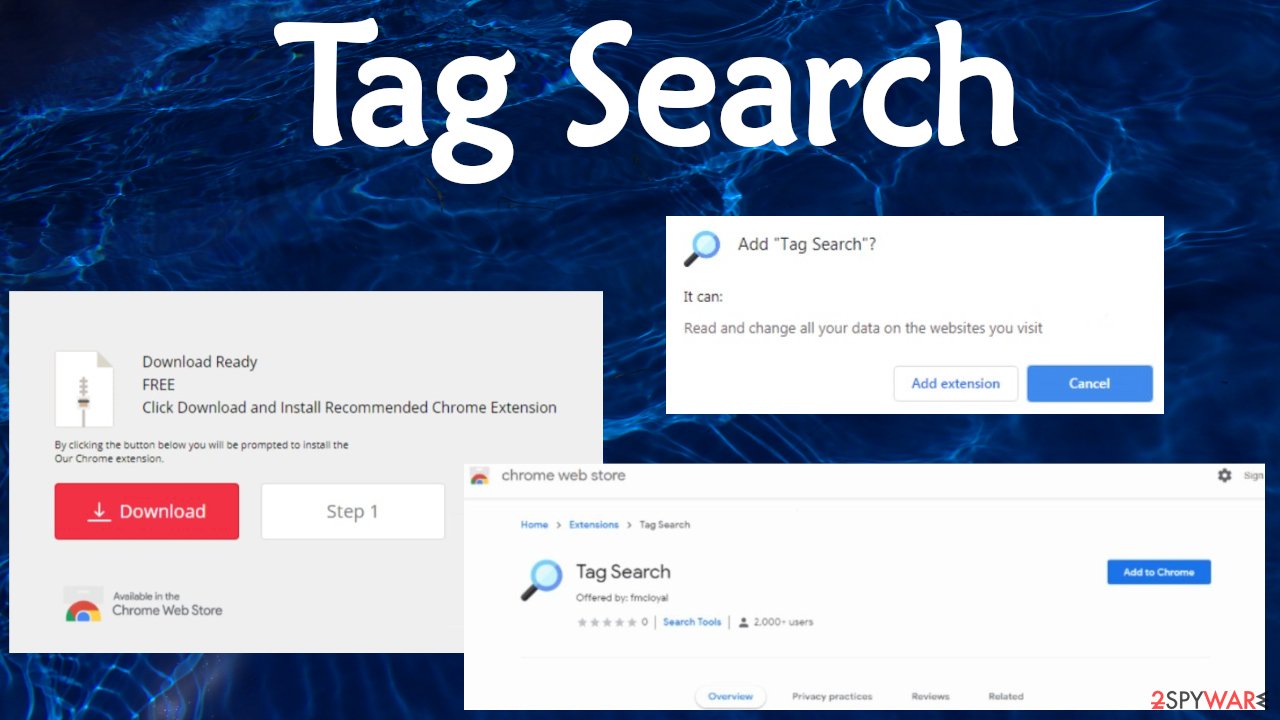Tag Search (Virus Removal Guide) - Free Instructions
Tag Search Removal Guide
What is Tag Search?
Tag Search – adware that will bombard your device with deceptive ads

Tag Search is falsely advertised as a useful addition to your device. In fact, when users install this adware which is categorized as a potentially unwanted program,[1] they see tons of all kinds of ads. This software shouldn't be used by anyone, no matter how alluring its false advertising campaign might be.
Tag Search ads are shown in many forms, including pop-ups, banners, in-text hyperlinks, etc. Some of them might even cover the whole browser window. The troubling thing about them is that they originate from a different source than the page you visit.
That makes them potentially dangerous as affiliated portals might have ill intentions. Furthermore, adware could open new browser tabs on-demand with sponsored websites. By reading this article, you'll find out how to eliminate it, how similar junkware spreads, and what to do to restore your system to a pre-contamination phase.
| name | Tag Search |
|---|---|
| Type | PUP, adware, redirect virus |
| Purpose | Generate traffic to third-party sites that would increase their popularity and sales |
| Symptoms | More than usual ads on frequently visited pages, slower device performance, slower internet connection |
| Related | Bing.com redirect |
| Risks | Ads and redirects could result in visiting malicious pages, which could lead to financial losses, privacy issues, malware infections, and alike |
| Distribution | Official browser web stores, software bundles, deceptive ads, fake Flash Player updates, file-sharing platforms |
| Removal | You could uninstall this adware manually, but to ensure that it's completely eliminated, scan your infected device with reliable anti-malware tools |
| System repair | Adware and infections alike cause havoc on system settings, which may result in abnormal device behavior. Resolve all system-related irregularities by running system diagnostics with the FortectIntego tool |
Developers of Tag Search virus created it with one goal in their minds – money. They don't care about their user privacy or safety. Their only goal is to generate traffic to their affiliated websites, and they can do it in two ways:
- showing ads that, when clicked, open a new tab with sponsored content,
- causing sudden redirects when affiliated pages are opened out of the blue.
Tag Search pop-ups, banners, and other ads are deceptive. They have nothing in common with the websites you'll be redirected to. These ads are made to lure you into clicking on them by showing amazing imaginary deals, celebrities and use other eye-catching techniques.
In some cases, you won't be able to close them, as the “X” button will be barely visible, it won't work, or will open a new tab with sponsored page either way. That means you could be forced to visit questionable pages just like if a Tag Search redirect would be triggered.
PUP developers and operators usually advertise one another. That means that the affiliated sites might contain other worthless programs. But that's the least of your worries, as other portals advertised by Tag Search adware could have malware, gambling, porn, tech support scams, push notification viruses, and other dangerous content that could be displayed.

Having adware installed on your device could lead to severe infections, identity theft, financial losses, and other disasters. Therefore, you should remove Tag Search immediately. Although you could eliminate it manually, we recommend using reliable anti-malware tools such as Malwarebytes or SpyHunter 5Combo Cleaner for your own safety.
A proper security tool will detect and delete the intruder automatically. When Tag Search removal is finished, it would be best if you would use another tool to eliminate any residual files, delete tracking cookies, and resolve any system-related issues. According to many user reviews, the best all-in-one tool for such a task is the FortectIntego system diagnostics software.
Software bundles usually contain installers for adware and other PUPs
Google Chrome Web Store and other official marketplaces remove adware, browser hijackers, and other PUPs from their shelves as soon as they realize that this software doesn't do what it is supposed to and is falsely advertised. Then such PUP developers use other, more sneaky techniques to distribute their products.
One of the most popular techniques used to spread potentially unwanted programs is software bundling. The trick behind this method is quite simple – a pack contains additional app installers, and all of them are preselected for installation. Thus when Recommended or Quick mode is chosen, all programs within the bundle are installed.

Not only third-party software vendors use this technique, but legitimate developers too. Therefore, the only way to avoid PUPs from software bundles is to pick the Advanced or Custom mode. Then go through the installation of every offered app and decline their entry to your device.
Directions for a quick but secure TagSearch virus removal
Having one potentially unwanted program on your device might lead to others knocking on your door in the near future. Adware such as Tag Search virus could even act as a gateway for severe computer infections. Therefore it shouldn't be used by anyone for their own safety.
It doesn't matter if you fell for the false advertising campaign or you have no clue how it got on your system – you have to remove Tag Search as soon as possible. You can do that by scanning your infected device with a trustworthy anti-malware tool that will automatically detect and eliminate it.
Computer infections make modifications to system files and settings to establish persistence. Thus after Tag Search removal, according to experts,[2] a system tune-up with compatible system diagnostics tools is in order. Otherwise, your device might exhibit abnormal behavior, such as BSoDs,[3] severe lag, freezing, and other failures. If the ads don't stop after you've completed the previous steps, please feel free to use our guides below.
You may remove virus damage with a help of FortectIntego. SpyHunter 5Combo Cleaner and Malwarebytes are recommended to detect potentially unwanted programs and viruses with all their files and registry entries that are related to them.
Getting rid of Tag Search. Follow these steps
Uninstall from Windows
Instructions for Windows 10/8 machines:
- Enter Control Panel into Windows search box and hit Enter or click on the search result.
- Under Programs, select Uninstall a program.

- From the list, find the entry of the suspicious program.
- Right-click on the application and select Uninstall.
- If User Account Control shows up, click Yes.
- Wait till uninstallation process is complete and click OK.

If you are Windows 7/XP user, proceed with the following instructions:
- Click on Windows Start > Control Panel located on the right pane (if you are Windows XP user, click on Add/Remove Programs).
- In Control Panel, select Programs > Uninstall a program.

- Pick the unwanted application by clicking on it once.
- At the top, click Uninstall/Change.
- In the confirmation prompt, pick Yes.
- Click OK once the removal process is finished.
Delete from macOS
Remove items from Applications folder:
- From the menu bar, select Go > Applications.
- In the Applications folder, look for all related entries.
- Click on the app and drag it to Trash (or right-click and pick Move to Trash)

To fully remove an unwanted app, you need to access Application Support, LaunchAgents, and LaunchDaemons folders and delete relevant files:
- Select Go > Go to Folder.
- Enter /Library/Application Support and click Go or press Enter.
- In the Application Support folder, look for any dubious entries and then delete them.
- Now enter /Library/LaunchAgents and /Library/LaunchDaemons folders the same way and terminate all the related .plist files.

Remove from Microsoft Edge
Delete unwanted extensions from MS Edge:
- Select Menu (three horizontal dots at the top-right of the browser window) and pick Extensions.
- From the list, pick the extension and click on the Gear icon.
- Click on Uninstall at the bottom.

Clear cookies and other browser data:
- Click on the Menu (three horizontal dots at the top-right of the browser window) and select Privacy & security.
- Under Clear browsing data, pick Choose what to clear.
- Select everything (apart from passwords, although you might want to include Media licenses as well, if applicable) and click on Clear.

Restore new tab and homepage settings:
- Click the menu icon and choose Settings.
- Then find On startup section.
- Click Disable if you found any suspicious domain.
Reset MS Edge if the above steps did not work:
- Press on Ctrl + Shift + Esc to open Task Manager.
- Click on More details arrow at the bottom of the window.
- Select Details tab.
- Now scroll down and locate every entry with Microsoft Edge name in it. Right-click on each of them and select End Task to stop MS Edge from running.

If this solution failed to help you, you need to use an advanced Edge reset method. Note that you need to backup your data before proceeding.
- Find the following folder on your computer: C:\\Users\\%username%\\AppData\\Local\\Packages\\Microsoft.MicrosoftEdge_8wekyb3d8bbwe.
- Press Ctrl + A on your keyboard to select all folders.
- Right-click on them and pick Delete

- Now right-click on the Start button and pick Windows PowerShell (Admin).
- When the new window opens, copy and paste the following command, and then press Enter:
Get-AppXPackage -AllUsers -Name Microsoft.MicrosoftEdge | Foreach {Add-AppxPackage -DisableDevelopmentMode -Register “$($_.InstallLocation)\\AppXManifest.xml” -Verbose

Instructions for Chromium-based Edge
Delete extensions from MS Edge (Chromium):
- Open Edge and click select Settings > Extensions.
- Delete unwanted extensions by clicking Remove.

Clear cache and site data:
- Click on Menu and go to Settings.
- Select Privacy, search and services.
- Under Clear browsing data, pick Choose what to clear.
- Under Time range, pick All time.
- Select Clear now.

Reset Chromium-based MS Edge:
- Click on Menu and select Settings.
- On the left side, pick Reset settings.
- Select Restore settings to their default values.
- Confirm with Reset.

Remove from Mozilla Firefox (FF)
Remove dangerous extensions:
- Open Mozilla Firefox browser and click on the Menu (three horizontal lines at the top-right of the window).
- Select Add-ons.
- In here, select unwanted plugin and click Remove.

Reset the homepage:
- Click three horizontal lines at the top right corner to open the menu.
- Choose Options.
- Under Home options, enter your preferred site that will open every time you newly open the Mozilla Firefox.
Clear cookies and site data:
- Click Menu and pick Settings.
- Go to Privacy & Security section.
- Scroll down to locate Cookies and Site Data.
- Click on Clear Data…
- Select Cookies and Site Data, as well as Cached Web Content and press Clear.

Reset Mozilla Firefox
If clearing the browser as explained above did not help, reset Mozilla Firefox:
- Open Mozilla Firefox browser and click the Menu.
- Go to Help and then choose Troubleshooting Information.

- Under Give Firefox a tune up section, click on Refresh Firefox…
- Once the pop-up shows up, confirm the action by pressing on Refresh Firefox.

Remove from Google Chrome
Delete malicious extensions from Google Chrome:
- Open Google Chrome, click on the Menu (three vertical dots at the top-right corner) and select More tools > Extensions.
- In the newly opened window, you will see all the installed extensions. Uninstall all the suspicious plugins that might be related to the unwanted program by clicking Remove.

Clear cache and web data from Chrome:
- Click on Menu and pick Settings.
- Under Privacy and security, select Clear browsing data.
- Select Browsing history, Cookies and other site data, as well as Cached images and files.
- Click Clear data.

Change your homepage:
- Click menu and choose Settings.
- Look for a suspicious site in the On startup section.
- Click on Open a specific or set of pages and click on three dots to find the Remove option.
Reset Google Chrome:
If the previous methods did not help you, reset Google Chrome to eliminate all the unwanted components:
- Click on Menu and select Settings.
- In the Settings, scroll down and click Advanced.
- Scroll down and locate Reset and clean up section.
- Now click Restore settings to their original defaults.
- Confirm with Reset settings.

Delete from Safari
Remove unwanted extensions from Safari:
- Click Safari > Preferences…
- In the new window, pick Extensions.
- Select the unwanted extension and select Uninstall.

Clear cookies and other website data from Safari:
- Click Safari > Clear History…
- From the drop-down menu under Clear, pick all history.
- Confirm with Clear History.

Reset Safari if the above-mentioned steps did not help you:
- Click Safari > Preferences…
- Go to Advanced tab.
- Tick the Show Develop menu in menu bar.
- From the menu bar, click Develop, and then select Empty Caches.

After uninstalling this potentially unwanted program (PUP) and fixing each of your web browsers, we recommend you to scan your PC system with a reputable anti-spyware. This will help you to get rid of Tag Search registry traces and will also identify related parasites or possible malware infections on your computer. For that you can use our top-rated malware remover: FortectIntego, SpyHunter 5Combo Cleaner or Malwarebytes.
How to prevent from getting adware
Protect your privacy – employ a VPN
There are several ways how to make your online time more private – you can access an incognito tab. However, there is no secret that even in this mode, you are tracked for advertising purposes. There is a way to add an extra layer of protection and create a completely anonymous web browsing practice with the help of Private Internet Access VPN. This software reroutes traffic through different servers, thus leaving your IP address and geolocation in disguise. Besides, it is based on a strict no-log policy, meaning that no data will be recorded, leaked, and available for both first and third parties. The combination of a secure web browser and Private Internet Access VPN will let you browse the Internet without a feeling of being spied or targeted by criminals.
No backups? No problem. Use a data recovery tool
If you wonder how data loss can occur, you should not look any further for answers – human errors, malware attacks, hardware failures, power cuts, natural disasters, or even simple negligence. In some cases, lost files are extremely important, and many straight out panic when such an unfortunate course of events happen. Due to this, you should always ensure that you prepare proper data backups on a regular basis.
If you were caught by surprise and did not have any backups to restore your files from, not everything is lost. Data Recovery Pro is one of the leading file recovery solutions you can find on the market – it is likely to restore even lost emails or data located on an external device.
- ^ PUPs Explained: What is a “Potentially Unwanted Program”?. Howtogeek. Online technology magazine.
- ^ Faravirus. Faravirus. Spyware news and security.
- ^ Blue screen of death. Wikipedia. The free encyclopedia.
